Tuesday, May 28, 2013
Saturday, April 20, 2013
UPDATE ~ Posted earlier and as of April, 2013, the link in this blog still works.
I often feel I alternate between two different mindsets: Sometimes I go with the flow and other times I stick to the tried and true like glue; I love order but I have a hard time maintaining it; I can do quality control on a huge project, strictly enforcing all the known rules but when the project is running out of time, I can throw all that to the winds and just wing it.
I once saw myself in my mind's eye actually wearing two hats. Somebody said to me, "You can't do that!" and I said "Watch me!" I felt like the picture was from God, smiling and saying, "Don't worry, I made you like that! I like you like that!"
The test below confirms what I suspected. There's a link at the bottom if you want to take the test yourself. If you do, I invite you to share what you learn in the comments section.
Oh! By the way, when you go to the link, you can skip that big Q at the top - it takes you to a link elsewhere. Start with the test right after the Q.
| You Are 45% Left Brained, 55% Right Brained |
The left side of your brain controls verbal ability, attention to detail, and reasoning.Left brained people are good at communication and persuading others. If you're left brained, you are likely good at math and logic.Your left brain prefers dogs, reading, and quiet. The right side of your brain is all about creativity and flexibility.Daring and intuitive, right brained people see the world in their unique way. If you're right brained, you likely have a talent for creative writing and art. Your right brain prefers day dreaming, philosophy, and sports. |
Friday, September 07, 2007

We walked after dark tonight and for the first time in a long time, there was no rain and the sky was clear of clouds. Our path took us past our community to a dark meadow near a small creek and it was there that the stars jumped out at us. There's been so much rain here in the hill country that we haven't seen stars for a long time. I had forgotten how breathtakingly beautiful they could be on a clear, dark night! The Big Dipper was just overhead, positioned as if to pour its contents down on us. Off in the trees along the creek, two fireflies blinked off and on as clear and bright as if turning a light off and on. These were different from the ones we had earlier this year: not a cloud of them as before but their light was bigger, stronger, clearer.
On the way home I found myself singing, "The stars at night are big and bright
RECORDED BY PERRY COMO & BING CROSBY
This 1941 song features lyrics by June Hershey and music by Don Swander. The song was first recorded by Perry Como with Ted Weems and His Orchestra on December 9, 1941 for Decca Records. It spent five weeks at the top of Your Hit Parade in 1942.
The song was also recorded by Bing Crosby in 1949. That version reached #3 on the Billboard charts that year. Other famous artists to record the song include Ray Charles, Hank Thompson, Bob Grant, George Strait and Nickel Creek. The University of Texas Longhorn Band performs the song during each football pregame, and the Texas Christian University Horned Frog Marching Band performs an arrangement during each pregame also. Fans sing "Take Me Out to the Ballgame" followed by "Deep In the Heart of Texas" during the 7th inning stretch of Houston Astros baseball games.
ALSO SUNG BY TEX RITTER & GENE AUTRY
The song's title was borrowed for a 1942 western film starring Johnny Mack Brown as a man instrumental in restoring Texas to the United States following the Civil War. It featured Tex Ritter singing the title song. Gene Autry sang the song in "Heart of the Rio Grande" in 1942. His version may be the most well known.
The stars at night, are big and bright, deep in the heart of Texas, The prairie sky is wide and high, deep in the heart of Texas. The sage in bloom is like perfume, deep in the heart of Texas, Reminds me of, the one I love, deep in the heart of Texas.
The coyotes wail, along the trail, deep in the heart of Texas, The rabbits rush, around the brush, deep in the heart of Texas. The cowboys cry, "Ki-yip-pee-yi," deep in the heart of Texas, The dogies bawl, and bawl and bawl, deep in the heart of Texas.
We didn't see any rabbits rushing but we did flush out a white-tailed deer ahead that showed his "white flag" as he scrambled ahead of us.
Labels: Deep in the Heart of Texas, Gene Autry, Heart of the Rio Grande, Johnny Mack Brown
Saturday, July 14, 2007

with deer - they are bounding all over the place, white tails flying: bucks, does, fawns. We've seen several sets of spotted twins. Not up close. The town deer let you get up close, but we live in a rural area, a small valley with a creek and small lake that is a haven for wildlife of all kinds. More than anything else, though, we have deer. That's always been true but even more so now.
UNUSUALLY HEAVY RAINS
According to the Kerrville Daily Times, unusually heavy rains here in the Texas Hill Country have brought about a record-breaking deer population.
“Last year was about the worst that anyone can recall experiencing, and this year is about the best year anyone can recall experiencing,” said Mitch Lockwood, a wildlife biologist with the Texas Parks and Wildlife Department in Kerrville. “The conditions are so good that if it didn’t rain for the rest of the summer, we wouldn’t expect to see a rise in mortality among the fawns this fall.”
OVER 100 PERCENT INCREASE IN BIRTH RATE
The Daily Times continued, "The favorable weather conditions have helped keep deer populations healthy, and sparked over a 100 percent increase in birth rates; The average faun rate is between 30 and 35 percent, while estimates this year predict a birth rate between 67 and 75 percent or higher, according to Lockwood. The 2007 deer population could be the highest in living memory, which could potentially cause problems with local ecosystems."
"Deer consume a great deal of vegetation, and an over-abundance of deer could jeopardize a wide variety of plants and foliage. Lockwood said that any animals depending on those plants, including endangered species like the Golden-Cheeked Warbler, could also be at risk."
DEER POPPING UP EVERYWHERE
So we may have a problem developing. But for now, we are enjoying the deer, especially the young ones. My husband, father and I walked down a trail toward a meadow that we often see a few deer in. My Dad was visiting and wanted to see some deer. It was almost twilight, when they typically feed, but we didn't see any deer in the meadow. I thought he was going to be disappointed. The weeds, wildflowers and grasses on both sides of the path were extremely dense and at times shoulder high. Before we started out, I had no idea they were that tall or thick. As we walked, deer started popping up out of the vegetation, showing their tails like white flags to us and heading for the surrounding woods. As we continued toward the meadow, the activity all around us was unbelievable. It was a short walk, but all in all we estimate that we saw at least 25 deer, maybe more.
What a wonderful surprise!
Labels: deer, father, Kerrville Daily Times, vegetation
Thursday, June 07, 2007

Last night D.H. (Dear Husband) and I sat on our back porch and watched the water in our small lake ripple as the fireflies came out. We then noticed the silhouettes of three deer in the moonlight munching grass in a neighbor's backyard. I sighed deeply several times and silently gave thanks to God once again for moving us to this beautiful small rural valley.
Something of the joy I experienced in my youth returned to me. Back then there was much porch-sitting in the cool of the evening. My grandmother was usually shelling peas or cracking pecans. The rest of us sat quietly, talking little, just enjoying being together and watching nature's unfolding beauty as the sky turned various shades of dark. The best part was when the fireflies would appear and randomly light up, as if by magic. They were so plentiful back then, we kids would run around catching them and filling Mason jars.
Fast forward several years and they seemed to have disappeared. D.H. and I often talked about why we didn't see them anymore. They seemed to have become extinct, at least in our part of the world. He blamed fire ants. After hearing about someone buying ladybugs online, I thought about searching the Internet to see if they were available for sale anywhere. But I never did, and now I don't have to.
Twice lately we have walked to the back of our community at dark, flashlight in hand. There, where the cultivated property ends at a creek on one side and a ranch on the other, hundreds of fireflies on the dark hill beyond stand out against dark cedar and live oaks, twinkling like tiny Christmas lights, randomly blinking.
D.H. just read an article in the newspaper that in another part of the world - and only in that one place - there are fireflies that blink all at the same time. Everywhere else they blink randomly: here one and there another, all darting around leaving a light trail behind.
I've always liked watching lush darkness fall upon the waiting world but, without the fireflies of my youth, the joy hasn't been there ... until now. Sigh. Thank you, Lord!
Photo by Christine Wainwright
Friday, May 11, 2007

We didn't plan on taking Scenic 390 but it was the closest way back to 290 after we missed it along our northwesterly path through the backroads from Conroe to the Texas Hill Country.
Detouring Through Burton
Our misadventure apparently started in Brenham but we didn't realize our mistake until we were well on our way to North Texas on 36 North. That's how we lucked into the happy experience of detouring through Burton via 390.

No Disappointment: Picture This
I am always interested in scenic drives and, I must add, often disappointed. But not this time! Scenic 390 was the first road in the state to get the designation of "Scenic" and it is well deserved for many reasons. Picture this: old oaks everywhere, tall and wide, sprawling over the countryside, picket fences along both sides of the road, fields of mixed wildflowers with bluebonnets giving the open spaces a blue cast, plentiful overflowing stock tanks, sleek horses, fat cattle of many different denominations, beautiful homes and farms with names. All this and more: most of the road hugs a ridge that affords a grand view of hilly terrain to the north.
Lovely Little Town
When we got to Burton signs were out announcing their 18th annual Cotton Gin Festival. I
 t was a lovely little town with beautiful well-maintained "antique" homes and buildings. I don't remember seeing another small town that was as attractive and inviting as this one. I really wanted to stay but D.H. had already indulged me in a lengthy stop at the VF Mall in Hempstead, so I knew there was "no way."
t was a lovely little town with beautiful well-maintained "antique" homes and buildings. I don't remember seeing another small town that was as attractive and inviting as this one. I really wanted to stay but D.H. had already indulged me in a lengthy stop at the VF Mall in Hempstead, so I knew there was "no way."Upcoming Events

But there's always next year! If this article has piqued your interest, the 19th Annual Cotton Gin Festival will be April 18-20, 2008. And if you can't wait until then, there's the Barn Dance and Gala Dinner October 20 of this year. For more details and extensive information on the cotton gin, click here.
1st photo by bennypix
2nd photo by Bob.Rosenberg
Labels: 390, antique, bluebonnets, Brenham, Burton, Cotton Gin, Hempstead, Scenic Drive, Texas, VF Mall, wildflowers
Wednesday, April 25, 2007
Previously - down the page a bit - I bid goodbye to our swans, thinking they would do as they usually do: head north in early April. But it turns out that I don't know much about "swanology." All seven swans recently reappeared and are still here.
 After the young ones matured, they paired off and left, seemingly to nest in a more secluded area. But apparently the heavy rains we had washed away their nests and they came back to their home waters to enjoy the delicacies in the waters here. One of their favorite things is the corn our residents liberally provide them with. I've heard it said that if we feed them maybe they won't leave. I'd love it if they stayed but I think they will heed the "call of the wild" and head further north when it gets warmer here. So far we have had an unusually wet and cool spring.
After the young ones matured, they paired off and left, seemingly to nest in a more secluded area. But apparently the heavy rains we had washed away their nests and they came back to their home waters to enjoy the delicacies in the waters here. One of their favorite things is the corn our residents liberally provide them with. I've heard it said that if we feed them maybe they won't leave. I'd love it if they stayed but I think they will heed the "call of the wild" and head further north when it gets warmer here. So far we have had an unusually wet and cool spring.
Since I've already posted many photos of the "Magnificent Seven," this time I will provide something different. When the family returned, I noticed those that had mates doing something I can only call "necking." Maybe that's not what it's called but it does seem to be an exchange of affection among the pairs. See for yourself!
Labels: swans
Wednesday, March 28, 2007
It's traditional on my birthday that we take a little trip and look for bluebonnets. We have countless photos of our children - and us - sitting in fields of bluebonnets. Now that it's just us, we skipped that part.
When we lived in The Megalopolis (Houston), there were always bluebonnets to be found on my birthday. Hubby usually spotted the first ones along T.C. Jester Boulevard while going to work. Then our annual trip would involve going to Chapel Hill through Hempstead so we could see fields of blue.
This year we live in the Texas Hill Country and we had to put forth more effort for less reward. Our only sighting was at a picnic area near Canyon Lake. It was a small patch but it was beautiful and I was glad for it. I picked one. Just one!
The THC is known for wildflowers - Lady Bird Johnson saw to that - but they are late this year. Last year we didn't have any and there was some talk that the continuing drought might have lasting effects. But experts say this will be a good year, there're just a little late.
Whew! I'm glad for that. I've seen gorgeous fields of them in Navarro and Ellis Counties on past birthdays, as well as Harris and surrounding counties. But my favorite viewing area is the Willow Loop, just north of Fredricksburg. It's spectacular. I'm looking forward to driving through there in another week or two.
Wherever you are driving this Spring, enjoy the view!
Photo by http://www.flickr.com/photos/tmmtx76
Originally uploaded by tmmtx76.
Friday, February 02, 2007
LONELY LAKE
Twice now I have looked out at the lake and seen only ripples from the wind. The parade of regal graceful swans has ended. The absence of seven large white swans has created an unfillable void. After their leave-taking, I did take pleasure in the antics of the 35-50 wild diving ducks. But this morning marks the second time they, too, have flown off.
SAD LADY
For a couple of weeks before they left, I watched them pair off: two here, two there, and

MATING SEASON
Their going wasn't totally unexpected. Last year the few that were here left around the end of January, despite the sometime twice daily feedings of corn by several residents. Yesterday I spied one pair in a more remote lake half a mile from here. Obviously, they wanted their privacy through the mating season. Last year, one pair nested there, where it was safer, and in April were seen leaving with five babies, accounting for the magnificent seven that returned here September 1.
NEXT YEAR?
There are now seven that consider our backyard their home lake. I wonder how many will return next year?
Thursday, January 18, 2007
NO ICE -- NO SWANS
This afternoon we were able to go outside and walk for the first time in days. No more slippery icy conditions, no more fierce freezing wind, and no more beautiful snow! The snow I miss. Both the fluffy falling of it (that was really beautiful!) and the white shiny banket that covered the barren landscape.
Where are they?
Because we back up to the lake and also have large sliding glass doors, we have had an excellent view through the seige of bad weather. Yesterday I was treated to a flyby of the seven swans that have lived here since Thanksgiving. They hovered just above the water. You wouldn't believe the clatter as 14 large wings beat the air together. Often they also drag their webbed feet in the water, sprayng multiple plumes skyward as they fly. Today I was anxious because I hadn't seen them.
My husband noticed, too, that we hadn't seen the swans. As large as they are and there being seven of them, they are hard to miss! So the first thing we did after bundling up for the walk was look for the swans. Although the lake is just a small private one, we don't have full view of it from any one spot. So as we walked we kept craning our necks, hoping to get a glimpse of a large spash of white, preferably several large splashes of white. Well, it never happened!
FUR NOT FEATHERS
I thought maybe the swans got tired of the cold weather and headed someplace warm. But if that were true, why didn't they leave earlier? Why wait until the thaw? The lake seems empty and lifeless without them. Well, almost. There are the lesser creatures: 30 or so diving ducks, 4 mallards, and 2 domestic ducks. And just a little while ago I saw something that was uncommon. Instead of feathers, it had fur. Was it a beaver? I'm not sure but definitely something like that. However, there is nothing to compare with seven swans swimming by like royalty on parade.
Sigh....I hope they come back.
Wednesday, January 17, 2007
ROBIN IN THE SNOW
Doesn't he look cold!
IT'S SNOWING!
This is our second winter in the Texas Hill Country and, to our delight, it is snowing. Not just fluffy flakes but big beautiful globs of snow are coming down. As I looked out the glass patio doors toward the small lake there, I noticed a robin perched amid the snow in the large live oak there. A robin in the snow! I knew it was a robin because of it's red breast. And also because I saw a whole flock of them when I was walking a couple of weeks ago. I did some research and learned that their love for the berries of our ash junipers brings them here in the winter. That, and because it is usually warmer here than up north where they came from.
I-10 IS CLOSED
The temperature has been hovering around 20. On the news I hear that I 10 is closed from Bourne, about 30 miles east of her, to an unnamed distance west. I actually thought I heard them say to CA but that seems a bit hard to believe.
We've had no reason to get out. Thank God! No mail delivery today or yesterday and we didn't get our newspaper.
SEVEN SWANS ARE STILL ASWIMMING
The seven swans are still aswimming in the lake and came up hoping we would throw them some corn. Raymond did but reported it was slippery to do so. I ventured out the back porch to take some photos and into the carport to look at the streets better but that is all.
DIVING DUCKS AND OTHERS
There look to be about 35 of the diving ducks that only come in the winter swimming back and forth in the lake. And I saw the 4 male mallards that live here year round. Raymond said he saw the two domestic ducks: Blackie and Whitie, he calls them. I like to call them Rae and X-Ray because they are opposites in their coloring.
That's my report on happenings in the frosty Texas Hill Country today.
Photo by richardrichard -
http://www.flickr.com/photos/richardrichard
Tuesday, January 09, 2007

It's Winter on the Edwards Plateau where I live. The night-time low is often in the 20's so imagine my surprise when I came across a large flock of robins in a grove of trees near my home.
"Robins!" My eyes said. "Impossible," my mind said back - "it's not spring. Everyone knows you see robins in the Spring." But the distinctive red breast of the robin was obvious.
I checked the Texas Parks and Wildlife brochure by Mark W. Lockwood entitled Birds of the Edwards Plateau, A Field Checklist, and found on page 11 that American Robins are found in abundant numbers during the months of January, February, and March on the Edwards Plateau. So, my eyes had not deceived me!
Shortly after, Bill Lindermann, who writes a column in our local paper called Hill Country Birding, had a long article about the phenomena. It seems the birds love the berries that we normally have in abundance. And though it may seem cold to me, the robins find it much warmer than in northern climes.
Photo by Lucina M
Friday, December 15, 2006
Angels in the Fire
Some people see angels in the fire in this photo. What do you see? Do you believe in angels? Not the kind that dance in the fire but the kind that are messengers of God?
More important, what do you believe about the Christ child whose birth we celebrate on Christmas day?
And in the sixth month, God sent the angel Gabriel to Nazareth, a town in Galilee, to a virgin pledged to be married to a man named Joseph, a descendant of David. The virgin's name was Mary...Do not be afraid, Mary, you have found favor with God. You will be with child and give birth to a son, and you are to give him the name Jesus. He will be great and will be called the Son of the Most High. The Lord God will give him the throne of his father David, and he will reign over the house of Jacob forever; his kingdom will never end. Luke 1:26
Photo by Hello Hillary
Thursday, November 30, 2006
 GRANDBOYS GALORE
GRANDBOYS GALOREWe finally got all six grandboys together. (We have no grandgirls.) This was their first cousins' reunion!* Their ages are 6, 4, 4, 1, 2 and 2-1/2.
They fished, fed the swans, got close to some deer, and fished again. Another favorite thing to do was to throw whatever they could find into the water: acorns, stones, pecans. The stones kept getting bigger and bigger - because, of course, the bigger the stone, the bigger the splash! We had to draw the line at boulders.
*I wasn't sure "reunion" was the proper term since this isn't a re-union but a first event. Dictionary.com seems to approve of this usage, not as its first offering but its third:
| 3. | a gathering of relatives, friends, or associates at regular intervals or after separation: a family reunion. |
Monday, October 30, 2006


These are the two domestic ducks that reside in the lake behind our house. I call them Salt and Pepper or Rae and X-Ray. They occasionally fly above the lake for a short distance but I have never known them to leave the lake. For some reason I think of Rae as being the female of the couple. I can't really explain why - just something in her manner. You never see these two apart.
Monday, October 16, 2006

Previously (August 9) I had expressed delight in the nest Lady M had made behind a bush in front of my house. She deposited 5 eggs there and several of us in the neighborhood dared to anticipate ducklings. Others dissed Lady M saying last year she had failed in her maternal duties.
NAUGHTY LADY?
Well, the nay-sayers were right! And I'm giving serious to changing her name to Naughty Lady. The truth is that she did not like being separated from her four male mates. She was diligent to make the nest and deposit the eggs there and I think she really intended to follow through with them. For several days the male mallards hung around the house, giving her moral support while she was doing her duty. Once I even found her companions asleep in the middle of the nearby road and tried unsuccessfully to urge them our of danger back to the grass.
DISHARMONY AMONG DUCKS
Then came the day my husband heard her screeching, squawking and carrying on. This was all directed at her male companions who had deserted her and gone for a swim in the lake. Contritely, they started toward her. She then thumbed her nose (beak) at them and flew petutantly away. That was the end of the lonesome duty of nest setting. The whole bunch of them not only abandoned the nest but this whole end of the lake for some time.

SAD ENDING
A sad ending to our hopes and dreams of fuzzy little Mallard ducklings to repopulate our lake! I'm not sure I dare to hope that next year will be any better...Well, maybe she is entitled to three tries before being ruled "out."
Top Photo by hddod @flickr CC
Sunday, October 01, 2006
I thought about calling this article The Magnificent Seven...but since I've already headlined the return of the swans...and given
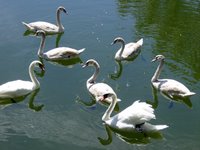 them another headline when the early arrival of three turned into six...what do I do now that there are seven?
them another headline when the early arrival of three turned into six...what do I do now that there are seven?MISPLACED EXCITEMENT?
At this point I need to tell you that the second time (or was it the third or fourth?) that I excitedly told my oldest son that we had swans in our backyard, he said, "Mom, you already told me about the swans."
DADDY SWAN APPEARS

So, I decided not to headline the fact that the daddy swan has now joined his mate and five offspring in our backyard. Photos? Yes. A screaming headline? No. I chose to start out with something light such as Bird Business. But after looking at that a while, it seemed ho-hum lame, so I moved on to the current headline, with apologies to my son. (And then snuck in this subhead about the Daddy's arrival.)
SWAN FANS UNDERSTAND
 , RIGHT?
, RIGHT?Still, I'll bet all you swan fans would think it incredible to have SEVEN swans as neighbors; you don't think I'm overreacting, do you?
Tuesday, September 26, 2006

Kerrville Schreiner Park is a 513-acre recreation area and camping park adjacent to the Guadalupe River and across from Flat Rock Lake in Kerr County, Texas.
It began as a city park built by the CCC in the 1930s and was then deeded to the State of Texas and became one of the Texas State Parks. For the last three years it has again belonged to the city of Kerrville, which has done extensive improvements and upgrades.
HEADQUATERS LOCATION AND TIMES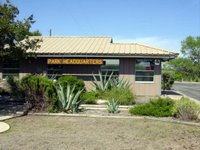
The park is located on State Highway 173, also known as the Bandera Highway. SH 173 can be reached from SH 16 or Loop 534. Coming from Kerrville, park headquarters is on the left. It is open 7 days a week year-round; 8 a.m. to 5 p.m. daily. The main gate is open from 8 a.m. to10 p.m.The busy season is described as being March through Thanksgiving.
ALONG THE RIVERBANKWe tried three times on three different days before it was convenient for park personnel to allow us a 15-minute “drivethrough.” We were not allowed to drive through the larger part of the park so we saw only a small portion of the camping area available. I was very impressed with the limestone “fishing terrace” along the riverbank. A shaded picnic area with tables is adjacent.
times on three different days before it was convenient for park personnel to allow us a 15-minute “drivethrough.” We were not allowed to drive through the larger part of the park so we saw only a small portion of the camping area available. I was very impressed with the limestone “fishing terrace” along the riverbank. A shaded picnic area with tables is adjacent.
Nearby various kinds of floats, kayaks and canoes can be rented. The playgrounds near this area have been upgraded to what I can only call "elaborate."
TWO SECTIONS TO THE PARK
There are now 23 new air-conditioned park cabins, with six alongside the river. The remaining cabins are across 173 from park headquarters. Entry into that part of the park is through a gate that requires a code that comes with registration. That section of the park is the larger section, containing hiking and biking trails. Although a foot and bike trail is available across 173, many people will prefer to drive to the river.
TYPICAL HILL COUNTRY
Pa rk elevation is 1645 ft. Landscape is typical Hill Country with acres of juniper, live oak, and Spanish oak on the hills and arroyos. Other plants include redbud, sumac, buckeye, pecan, mesquite, and several varieties of flowers. White-tailed deer abound. Also present are: squirrels, armadillos, turkeys, jackrabbits, mallard ducks, and several species of birds. Fish include crappie, perch, catfish, and bass.
rk elevation is 1645 ft. Landscape is typical Hill Country with acres of juniper, live oak, and Spanish oak on the hills and arroyos. Other plants include redbud, sumac, buckeye, pecan, mesquite, and several varieties of flowers. White-tailed deer abound. Also present are: squirrels, armadillos, turkeys, jackrabbits, mallard ducks, and several species of birds. Fish include crappie, perch, catfish, and bass.
Available activities include boating, fishing, camping, picnicking, unsupervised swimming in the river, bird watching, hiking, walking, and cycling.
July average temperature high is 94 degrees. January average low is 34 degrees. Humidity year-round is low with September the wettest month. First freeze can be as early as November 7; last freeze, April 5.
AVAILABLE FACILITIES
Facilities include restrooms with hot showers; day use picnic sites; campsites with water nearby; campsites with water and 50/30 amp electrical hookups and sewer con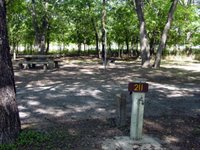 nections and shade shelters (pull-through); campsites with water and 30 amp electrical hookups (back-in and pull-through); campsites with water, 30 amp electrical hookups and sewer (pull-through).
nections and shade shelters (pull-through); campsites with water and 30 amp electrical hookups (back-in and pull-through); campsites with water, 30 amp electrical hookups and sewer (pull-through).
Also available are: a large group facility, a laundromat, concrete boat ramp, 8 miles of hiking trails, 6 miles of mountain bike beginner/intermediate trails, a lighted fishing pier, two age-graded playgrounds, and a convenience store within .5 miles of the park entrance.
RESERVATIONS & TRAIL MAP
Reservations can be made by calling park headquarters at 830.257.5392. A map of the park and trails is available by clicking here.
Tuesday, September 19, 2006
 ANOTHER BEAUTIFUL HILL COUNTRY SKY
ANOTHER BEAUTIFUL HILL COUNTRY SKY Right off, I admit I did not take this photo, someone else did! I had a choice to make: either run into the house and get my camera or live in the moment. I chose to enjoy what was happening all around me as the sun set and, in the afterglow, the sky turned first peachy-colored, then darkened to near-purple. On top of that, there was a rainbow right at the end of my street, to the east.
Betty, I'm really sorry you didn't get to see this Sunday night because I know you miss the sunsets you enjoyed in the Panhandle. And it may make you feel worse when I tell you I rang your doorbell! I didn't hang around banging on the door because I knew the window of glory would only last another few minutes. Please forgive me.
Sure enough, everything changed within 5 minutes as darkness fell on our little valley.
Oh! I forgot to tell you about the progression. First the horizon turned a peachy color, then the piled-up clouds changed, and then our lake reflected the color of the clouds. It was as if the whole world turned the same shade. But only for a few minutes. I'm sure there will be another beautiful sunset but it will be a long time before we have a sunset plus the lake plus the rainbow- all complementing each other in such a glorious combination.
Photo by Marada
Saturday, September 16, 2006
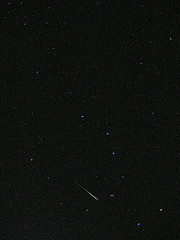 FIREWORKS IN THE SKY
FIREWORKS IN THE SKYLast night Sarah and I walked at twilight. First we checked out the northwest side of the creek, where a deer herd feeds. Then we walked over the dam and inventoried the resident birds of our lake. Our walks are never complete until we locate and count each one. Six swans? Check! Two domestic ducks? Check! Five mallards? Where? There!
We ended our walk on her deck, contemplating the star-laden sky. Sarah says she never fails to see a shooting star. She's good at spotting them and usually sees some that I don't. But not this night! I stretched out, face up and counted five. Wow! And the last one? Unbelievable. It was wide and long and burst into orange-red flames just as it came to the horizon. I've never seen anything like it! It was a beautiful evening. Sarah's deck makes an excellent star-gazing platform.
Photo by J P Stanley @flickrCC
Wednesday, September 06, 2006
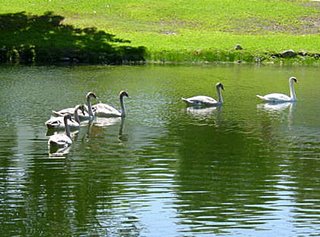
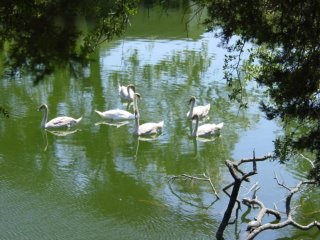

If you just can't get enough, click here for a slideshow of even more swans.
Monday, September 04, 2006
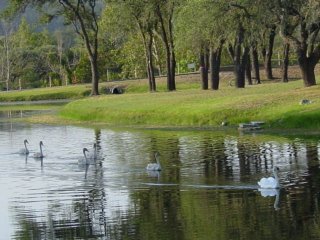
When we moved into our Hill Country home last January, there were four swans that greeted us. Literally. The first time we walked out to the small private lake behind our house, the male rose up, feet trailing, creating two large plumes of water as he flew toward us across the lake in that position. He made a loud trumpeting sound as he came straight at us. The female swans came behind but he was the spectacular one. I chose to take it as a greeting but others have told me he meant it more as a threat. But it was just too beautiful a sight to be threatening.
NESTED IN THE SPRING
Through the winter, they alternated between our lake and one just across the road. In the spring it was possible to see that one of the females was nesting there. The male swan stayed close to her and was very protective at that time. A friend of mine later saw the exodus of the mom swan and two babies in April. She said the male swan left in a different direction.
REMEMBERED THE "SWEET" SPOT
We really missed their graceful presence, hoped they would
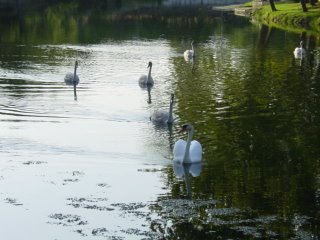 come back, and speculated about when that might be. Well! Friday I looked out and saw three swans land practically in my backyard. Two of them were gray and I remembered this was a sign they weren't full grown yet, even though they were almost the size of their mom. I grabbed my camera and snapped as many photos as I could before the sun went down. The first thing they did was take a lap around the old home pond in their stately, royal manner. Then they headed to the place where a neighbor often feeds corn to the ducks and swans. By that, I knew this was the same female as before and these were her two babies. Otherwise how would she have known of the "sweet" spot?
come back, and speculated about when that might be. Well! Friday I looked out and saw three swans land practically in my backyard. Two of them were gray and I remembered this was a sign they weren't full grown yet, even though they were almost the size of their mom. I grabbed my camera and snapped as many photos as I could before the sun went down. The first thing they did was take a lap around the old home pond in their stately, royal manner. Then they headed to the place where a neighbor often feeds corn to the ducks and swans. By that, I knew this was the same female as before and these were her two babies. Otherwise how would she have known of the "sweet" spot?MULTIPLIED SWANS
Imagine my surprise the next morning when I looked out and there were SIX swans, five of them grey. Where did the other three come from? My husband observing how dependent they were on the mama swan decided that she must have led the first two here and
 returned overnight to get the other three. At first we were confused about where she could have gotten the others, since she had only been seen with two when she left. After thinking it over, it is probable she made two trips when she departed, like she did coming back. Only two babies were seen then, but there must have been more in the nest because all five of the grey teenage swans are the same size.
returned overnight to get the other three. At first we were confused about where she could have gotten the others, since she had only been seen with two when she left. After thinking it over, it is probable she made two trips when she departed, like she did coming back. Only two babies were seen then, but there must have been more in the nest because all five of the grey teenage swans are the same size.We are so glad they returned. Nothing else in nature is quite as graceful and beautiful as a swan.
Thursday, August 31, 2006
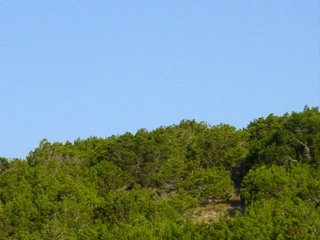 BAT-FREE SKY!
BAT-FREE SKY!This may look like a photo of nothing to you but to me it looks like relief. The bats are gone! When they first came I enjoyed the novelty of their presence. But then more came, and still more. They especially liked to congregate on a hilltop across from my home, where I usually begin my walk.
COLLISION COURSE
One morning a few days ago I started to walk in my usual direction and then just stopped and turned around. Not only was the sky full of bats but they were repeatedly swooping down low over the pavement where I was headed and I saw no way I could avoid being hit by the swoopers. At this point you may want to tell me that their built-in radar would have prevented such a close physical encounter. Yeah, I know. That is I know with my head, but my heart wasn't convinced. Nor my eyes. They told me that the sky was full of bats blocking my path and I was on a collision course with them.
I had read in the San Antonio Express News that this bat invasion was primarily young bats not likely to have rabies. I'm sure that's true (again, with my head). But the rest of me did not want to chance a personal physical encounter with the creepy creatures (or several of them!) even if they were in good health. Enough said!
BLESSED RELIEF
So please, rejoice with me that I'm now enjoying the blessedness of a bat-free sky and a bat-free walk over my usual turf. And did I mention it was also a nice cool morning with a temp of 65 here in our small rural valley in the Hill Country? Ahhhh! Relief!
Tuesday, August 22, 2006

There's something stirring in the evenings here that is more noticeable than the deer. That something is bats. They are swooping down and around our small community in great numbers. One hovered over me last night on my evening walk and made several investigative passes, checking me out. My husband said that to him, with his night vision, I looked like a giant ball of energy. He finally moved on, probably realizing I was too big to be dinner.
WINGED MAMMALS
Because they are so predominate right now, I decided to do some investigation of my own. My research revealed that bats aren't birds but instead are winged mammals. An article in the newspaper said that the mild winter just past left a large insect population, and that has attracted the Mexican free-tailed bats. Their favorite food is the corn earworm moth, but this summer they have millions of American snout butterflies to dine on in our area.
Mexican bats look creepy (especially when they decide to inspect you up close), but they protect South Texas crops from insects and their guano makes good fertilizer.
SEASONAL MIGRATION
Now is the beginning of the seasonal migration of Mexican free-tailed bats from Bracken Cave, which is about 30 miles southeast of San Antonio. The cave is home to the world'’s largest bat colony, estimated at between 20 and 40 million bats. The bats start leaving Bracken Cave in early August, and then usually wander the area before beginning their southward migration in October.
Sunday, August 20, 2006
 FIERCE ENCOUNTER ON HILLTOP
FIERCE ENCOUNTER ON HILLTOPWILDLIFE NEAR MY HOME
Many of my wildlife sightings here in the Hill Country have taken place on a hill near my home that has a thick cedar forest just to the right of a turn in the road. The favorite gathering place for the local deer herd is a feeding station there. It’s rare for me not to have a “deer” experience when I climb that hill, regardless of the time of day. I’ve written about the hungry deer several times and also shared my delight in observing the playful antics of two foxes. I’m still learning how to differentiate the many bird species there. And often from that height I can spot the mallards and domestic ducks that live in our small private lake in the small valley down below.
SURPRISED BY A GREAT HORNED OWL
One morning recently I was thinking that there couldn’t be anything new to discover at that spot when I was greatly surprised by the flyby of what could only be a Great Horned Owl, since it is the only large owl with ear tufts. I’ve never seen one in flight before or up close. Just as I was wondering if I had imagined him, he soared by again, circling me. I was delighted and a little bit scared as he was large, powerful and fierce looking, with his ear tufts that looked like horns and his bright yellow eyes fixed on me. Surely he wasn’t considering me for breakfast, was he?
GREAT HORNED FACTS

My new companion had dramatic coloring with well-defined markings. He was rusty brown, light gold and brown, with a white throat patch, with cross-barred under parts and dark bars on his extended tail. His wingspan looked to be between 4-1/2 to 5 feet and I would say he was about 3 feet in length.
After he had a good look at me and I at him, he disappeared in the thicket and I came home and did some research to verify what I saw and learn more about him. My research revealed that this must be a mature specimen because, although the young are similar in coloration to the adults, their barring and dark markings are not as crisp and defined and the ear tufts are smaller or not apparent.
I regret that I did not get to hear its call, which I understand is a distinctive “hoot” and is a way to distinguish males from females. The males usually give four to five hoots while females give six to eight hoots in a lower pitch. I also learned that the Great Horned Owl is very adaptable and inhabits every type of terrain in North America from sea level to 11,000-ft. elevation. A preferred habitat would include mature woods that offer maximum roosting concealment and water near open habitats for hunting.
NEW FEAR FOR RESIDENT WILDLIFE
After reading about how great the Great Horned Owl’s predator skills are, I was worried about the safety of the small animals that I have come to enjoy in and around our small private lake. When I spied the foxes a few weeks ago, my first thought was that they were a threat to the few ducks that reside here. Now I was worried about the foxes, as well as the ducks and the lone Great Blue Heron in the next article down. This owl is known as an opportunistic forager that often chooses a high perch to scan for prey, although it will glide over areas where prey is likely to be, it will walk on the ground, and it has even been reported to wade into the water. Scarcely anything that moves is safe from this fierce predator. It will eat prey as small as insects and scorpions or as large as domestic cats, woodchucks, geese, and Great Blue Herons. It has no predators (a very unusual thing in nature!) and will eat anything from crayfish to young foxes.
1st photo by Brian Scott @flickrCC
2nd photo by Kevin Day @flickrCC
Friday, August 11, 2006
 CAN YOU SEE HIM?
CAN YOU SEE HIM?If you look in the lower middle of this photo, slightly to the left, you will see a Great Blue Heron. It's often seen in the small creekbed just past the lake dam near where we live. I've seen it many times but this is the first photo I've gotten. As I made my way forward to get a better, bigger image of the bird, it rose up on huge wings and took flight. Apparently it isn't very sociable! It's a very solitary bird, always just the one, although I have read of huge colonies of them.
Seeing the bird in flight is a wonderful experience, as it spreads its giant wings and soars upward. Which brings up the question of how fast can he fly? Two studies have measured these birds as having a cruising speed between 23 and 29 miles per hour.
DID YOU SEE HIM?
Did you locate the Great Blue in the first photo?
He
 re is a cropped version showcasing the bird, with its distinctive "S" shaped neck. Again, he's on the left.
re is a cropped version showcasing the bird, with its distinctive "S" shaped neck. Again, he's on the left.Sixty-nine percent of newborn Great Blue Herons die in their first year, although some have been known to live over 20 years.
Click here for a website with more information on Great Blue Herons.
Wednesday, August 09, 2006
 WHO'S EGGING ME NOW?
WHO'S EGGING ME NOW?That's what I thought when I returned from my walk and found this on my driveway. Then I remembered that I don't live in Megalopolis anymore with its many challenges but in a peaceful rural community.
FIRST THE FACTS
First of all, the splattered egg had not been there when I left for my early morning walk. Of that I was positive. Second, it was obviously a very fresh egg. So I pondered other possibilities as I watered our thirsty plants and bushes.
WHERE TO START?

I considered an investigation, but where would I start? As I came to the bush on the right, next to our front door, out stepped Lady M, our resident female Mallard. She stood still for a brief while and then waddled off. It looked like the only thing I needed to investigate was the bush she had been behind. Sure enough, nestled close to its
 root system, I found a nest of eggs.
root system, I found a nest of eggs.MYSTERY SOLVED
So why was the broken egg on my driveway? How did it get there? Here's what I think happened: Lady M was on her way to the nest to "deposit" the egg and she misjudged herself.
VISIONS OF DUCKLINGS

Since seeing the nest, I've been having visions of ducklings . . . baby Mallards!! We only have five mallards in our pond and two older domestic ducks that stay here year round. (Wild ducks and swans come in and out during the winter.) Lady M is the only hope we have for adding to our resident duck population. Is she up to the job? There's a difference of opinion among the neighbors. She herself was hatched here so she is well known. And she has her detractors. Some say she is irresponsible. But I'm willing to give her the benefit of the doubt. Several of us are pulling for her, that she's stay the course. I'll keep you updated.
©2006 by Jay KTX. The contents of this blog may be reproduced or forwarded by e-mail without change and in entirety for non-commercial purposes without prior permission from Jay KTX provided the copyright information is included.




